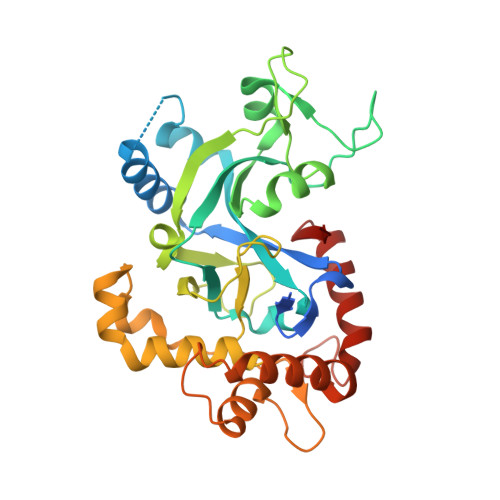Anti-Malarial Benzoxaboroles Target P. Falciparum Leucyl-tRNA Synthetase.
Sonoiki, E., Palencia, A., Guo, D., Ahyong, V., Dong, C., Li, X., Hernandez, V.S., Zhang, Y.K., Choi, W., Gut, J., Legac, J., Cooper, R., Alley, M.R., Freund, Y.R., Derisi, J., Cusack, S., Rosenthal, P.J.(2016) Antimicrob Agents Chemother 60: 4886
- PubMed: 27270277
- DOI: https://doi.org/10.1128/AAC.00820-16
- Primary Citation of Related Structures:
5FO4, 5FOC, 5FOD, 5FOF - PubMed Abstract:
There is a need for new antimalarials, ideally with novel mechanisms of action. Benzoxaboroles have been shown to be active against bacteria, fungi, and trypanosomes. Therefore, we investigated the antimalarial activity and mechanism of action of 3-aminomethyl benzoxaboroles against Plasmodium falciparum Two 3-aminomethyl compounds, AN6426 and AN8432, demonstrated good potency against cultured multidrug-resistant (W2 strain) P. falciparum (50% inhibitory concentration [IC50] of 310 nM and 490 nM, respectively) and efficacy against murine Plasmodium berghei infection when administered orally once daily for 4 days (90% effective dose [ED90], 7.4 and 16.2 mg/kg of body weight, respectively). To characterize mechanisms of action, we selected parasites with decreased drug sensitivity by culturing with stepwise increases in concentration of AN6426. Resistant clones were characterized by whole-genome sequencing. Three generations of resistant parasites had polymorphisms in the predicted editing domain of the gene encoding a P. falciparum leucyl-tRNA synthetase (LeuRS; PF3D7_0622800) and in another gene (PF3D7_1218100), which encodes a protein of unknown function. Solution of the structure of the P. falciparum LeuRS editing domain suggested key roles for mutated residues in LeuRS editing. Short incubations with AN6426 and AN8432, unlike artemisinin, caused dose-dependent inhibition of [(14)C]leucine incorporation by cultured wild-type, but not resistant, parasites. The growth of resistant, but not wild-type, parasites was impaired in the presence of the unnatural amino acid norvaline, consistent with a loss of LeuRS editing activity in resistant parasites. In summary, the benzoxaboroles AN6426 and AN8432 offer effective antimalarial activity and act, at least in part, against a novel target, the editing domain of P. falciparum LeuRS.
- Department of Medicine, University of California, San Francisco, California, USA Division of Infectious Diseases and Immunology, School of Public Health, University of California, Berkeley, California, USA.
Organizational Affiliation:
















